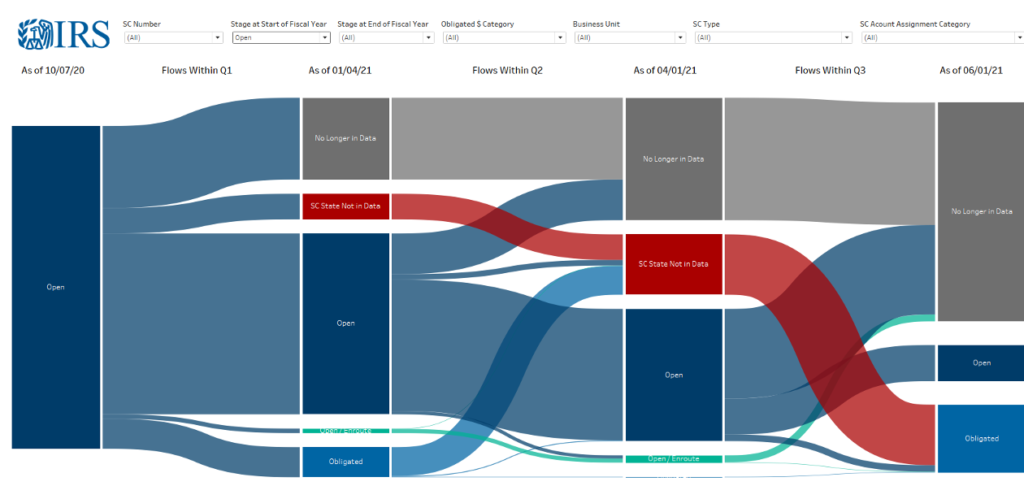Leveraging Data and Design Thinking to Drive Strategic Decision-Making
Leveraging Design Thinking to Help IRS Better Understand Their Users
Our approach to service design always starts with users and their desired outcomes. Since the heart of this project was to improve decision-making, we connected directly with decision-makers to understand why their procurement function is critical to IRS, what decisions are critical to moving the mission forward, and how they use data to make and communicate those decisions to key stakeholders throughout the agency.
At the same time as our qualitative discovery, we reviewed existing documented policies and practices within the agency and did some preliminary exploratory analysis on their existing data assets. We discovered, like many federal agencies, IRS was collecting sufficient, high quality data already but struggled with transforming that data into information that helped decision-makers tell a compelling story. Our Data Science team took some immediate actions to help decision-makers further trust the credibility of the data by validating data sources and formalizing relationships with data owners to ensure OCPO could reliably access key data sources.
As our confidence in understanding the mission and data, Technical Assent’s Data Science team turned their attention back to the users and the key mission decisions they needed to make. In this phase of the work, we use a Build-Measure-Learn approach to model the decisions with key data, create interactive visualizations, and work with users to evaluate how the visualizations aided their decision-making process. We matured the visual dashboards quickly and were thrilled to see users respond as they saw their intuitions backed by real data.
“Just had to tell you that I wanted to say ‘Drop the Mic!!’ after you made that statement about not everything being equally important. We need that statement reiterated over and over so that we can stay focused on what matters – aka ‘keeping the main things, the main things.’ That is at the heart of many of our struggles around here. Thanks for the wisdom and clarity!!”
Positioning Our Client for Long Term Success
Technical Assent worked with the agency to strengthen OCPO’s in-house capability – the tools, technology, and talent – as customer demand for more data-driven insights grew. We recommended business processes for managing intake of new customer requests and criteria to help manage the backlog based on mission priorities. We also documented our approach and transferred that knowledge to the government team, including proven best practices such as CRISP-DM, CMMI, and ITIL practices to ensure IRS staff can sustainably deliver relevant and reliable data services to their internal customers.
By combining HCD, agile methodologies, and quantitative data analysis we helped the IRS understand how to better visualize their data and put it to work for them in making better decisions. We did this WITH a growing IRS team, empowering them to reuse the blueprint we co-created and sustain the efforts in the future. And we’re confident the products are of immense value to decision-makers because they were included in every step of the process and saw their feedback become part of the final solutions.
How do you help equip your clients to make better strategic decisions?












 We are excited to announce that we have been accepted to the Electronic Federal Aviation Administration (FAA) Accelerated and Simplified Tasks (eFAST) contracting vehicle. The FAA divides eFAST work into functional areas and we now hold master ordering agreements in the following areas:
We are excited to announce that we have been accepted to the Electronic Federal Aviation Administration (FAA) Accelerated and Simplified Tasks (eFAST) contracting vehicle. The FAA divides eFAST work into functional areas and we now hold master ordering agreements in the following areas: small business contracts. eFAST streamlines the procurement process for all stakeholders using a web-based acquisition tool and automated workflows compliant
small business contracts. eFAST streamlines the procurement process for all stakeholders using a web-based acquisition tool and automated workflows compliant



